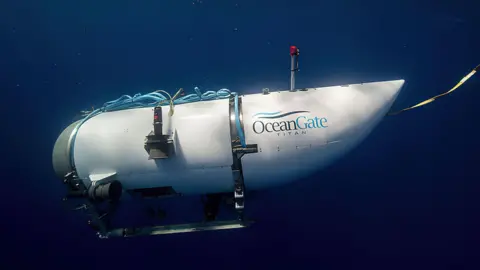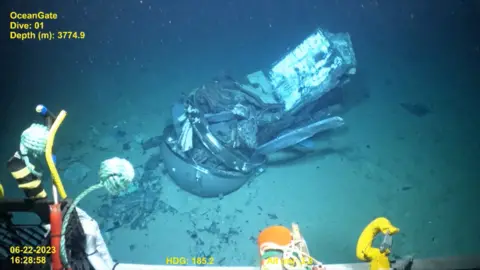ARTICLE AD BOX
'I'm not getting in it' - Former OceanGate employees decry Titan sub safety issues
The US Coast Guard has heard a week's worth of testimony from people close to the Titan submersible that imploded last June, killing all five aboard.
Investigators are seeking to uncover the details of what led to the tragedy and find recommendations that could prevent future deadly voyages.
Titan, operated by OceanGate, imploded less than two hours into its descent during a dive to the wreckage of the Titanic.
The accident led to questions over the submersible's safety and design, and the materials used in its construction.
Here are five takeaways from the first of the two-week set of hearings:
1. Crew's final words: 'All good here'
Investigators with the US Coast Guard revealed one of the crew's final messages before it lost contact with a ship above water: "All good here."
The hearing revealed other text messages between Titan and its mother ship as the deep-sea vessel began its trek to the sea floor to see the iconic British ocean liner that sank in 1912.
Support staff aboard the surface ship asked about the submersible's depth and weight.
Communications were patchy throughout the descent, according to investigators.
About one hour into the dive, the Titan sent a message at a depth of 3,346m that would be its last. The crew communicated it had dropped two weights.
Then communication was lost.

 Supplied via Reuters/AFP
Supplied via Reuters/AFP
Clockwise from top left: Stockton Rush, Hamish Harding, Shahzada Dawood and his son Suleman, and Paul-Henri Nargeolet were all onboard the Titan
2. Witness recalls last look at Titan crew: 'Five people smiling'
Mission specialist Renata Rojas, who helped with the doomed trip as a volunteer, testified before the US Coast Guard on her interaction with the crew before the sub descended.
At one point, Ms Rojas teared up while remembering "five people smiling" before boarding the Titan and heading below the water.
"They were just happy to go, that’s the memory I have," she said.
She remembered losing communication and asking colleagues: "We haven't heard from them, where are they?"
Ms Rojas, who previously visited the Titanic wreckage with OceanGate, admitted that the Titan submersible was not classified or registered.
"I knew the Titanic dive was risky, but I never felt unsafe," she said during the hearing.

 American Photo Archive
American Photo Archive
3. Whistleblower: Tragedy was 'inevitable'
OceanGate's former operations director David Lochridge testified to US Coast Guard investigators that he warned of potential safety issues before he was fired in 2018.
He claimed he was ignored.
Mr Lochridge said he believed the deadly incident with the Titan was "inevitable" as the company "bypassed" standard rules.
He was fired and sued by OceanGate for revealing confidential information, and he countersued for wrongful dismissal.
US court documents show Mr Lochridge had significant concerns with the Titan's design, including that it was made from carbon fibre which he warned would damage further with every dive.
He told US Coast Guard investigators the "whole idea" of OceanGate was "to make money".
"There was very little in the way of science," he said.
4. New footage reveals Titan wreckage
The US Coast Guard released new footage showing the wreckage of the Titan sub on the bottom of the sea floor.
The deep-sea vessel is seen with the "OceanGate" logo on its side as debris is scattered around it.
The vessel's tail can also be spotted among the wreckage as well as the submersible's wires, gauges and electronics.
A remotely operated vehicle obtained the footage.

 Reuters
Reuters
5. Leading submersible manufacturer: Titan was 'not ready for prime time'
Patrick Lahey, the co-founder and chief executive of leading submersible manufacturer Triton, told investigators he wasn't impressed by the Titan submersible.
Mr Lahey's company manufactures submersibles that descend to the deepest points of the ocean.
While not mandatory, he stressed the importance of certifying submersible vessels through a process that involves an extensive safety assessment carried out by independent marine organisations.
Mr Lahey told the panel there was no reason why the Titan submersible couldn't have been certified.
He toured the Titan sub that later imploded while on vacation in the Bahamas and said he "wasn't particularly impressed" by what he saw.
"It looked to me like a lot of the stuff was not quite ready for prime time," he added, saying he expressed his concerns to OceanGate.
Mr Lahey added that the vessel did not seem "particular well thought out".
"It just looked amateur-ish in its execution," he said.

 8 months ago
30
8 months ago
30








 English (US) ·
English (US) ·